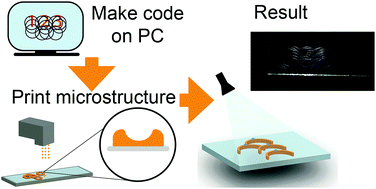Inkjet printing of specular holograms based on a coffee-ring effect concave structure†
Abstract
Inkjet printing is a promising direction for materials application and structuring. The proposed method for creating specular holograms on a variety of surface materials is based on creating a three-dimensional surface microstructure by controllable ink deposition. The foundation of the proposed approach is precise control of the applied ink containing titania nanoparticles with a high refractive index. This allows one to achieve a densely packed concave structure through the coffee-ring effect. Surface specular glints on the concave surface of the printed structure underlie the principle of this type of holography. The printed samples have high visibility and easy application and reproduction. Besides this, the retaining of high transparency and structure be applied to traditional print images or text. The presented method allows us to prove that inkjet printing is not only a method for layer-by-layer application of materials but also a method for creating complex three-dimensional functional optical structures. The proposed approach has direct applications in industry and can be used for additional holographic protection, along with showing researchers a different point of view on the inkjet printing method in general.



 Please wait while we load your content...
Please wait while we load your content...